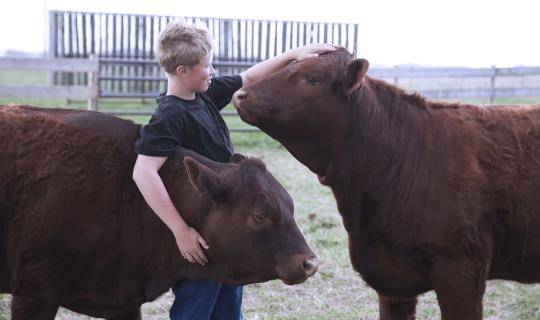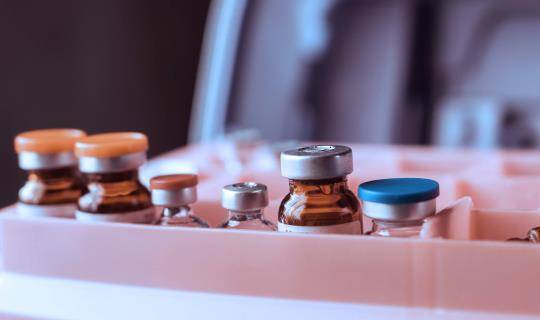Vaccination best practices can help achieve herd immunity
By Jerry Rusch, DVM

Optimal herd immunity goes hand in hand with a safe beef supply for consumers. A large part of achieving both includes properly reading and following product label directions, handling and storing vaccines correctly, and observing slaughter withdrawal times.
An established working relationship with a bovine herd health veterinarian is also of great importance — and will be necessary as over-the-counter antibiotics transition to prescription-only status by June 2023 [see article on page 13]. As part of a herd’s consulting team, a veterinary professional can help you with a vaccination and herd health program that includes treatment protocols. A vital part of this process is following Beef Quality Assurance (BQA) guidelines.
Read product labels and record vaccines used
First off, be sure to read and pay attention to the vaccine product label to ensure the product is utilized correctly.
Look at the expiration date on either the box or bottle. If a product is past its expiration date, it should not be used. If you have a question about this, ask the product manufacturer or your herd health veterinarian.
Also, read the usage indications. This explains what class of animal the product is meant for and what condition or pathogen it is useful against. These factors and when to give a vaccine are where your veterinarian’s input is critical.
Additionally, read the storage requirements; all vaccines require refrigeration. Before obtaining vaccines, make sure your storage refrigerator is in proper working order. Use a thermometer that displays both the current temperature and the high and low temperature over the last 24 hours. Some refrigerators lose their efficiency and may periodically freeze or heat up a vaccine, which makes it ineffective.
Other factors to consider are the dose of vaccine and the route of administration. Most vaccines and antibiotics are given either intramuscularly (IM), in the muscle, or subcutaneously (SubQ), under the skin. Some vaccines are given intranasally (IN), up the nose. Read and strictly follow these guidelines.
Keep written records of the products used, including administration dates, lot numbers, and serial numbers.
Select needle size and use correctly
Another factor of critical importance is proper needle size and length, as well as making sure to change needles every 10–15 animals. Change needles more frequently if the hide is wet, dirty, or if the needle becomes bent or burred. Make sure to give all injections in the neck, a BQA requirement. Utilize both sides, and space them no closer than one hands’ width apart.
For IM injections, use a needle that is 1 inch in length or longer. If giving SubQ vaccine, use a 3/4-inch or 5/8-inch needle. For adults, a 16-gauge needle is appropriate while an 18 gauge is best for a young calf [refer to Figure 1].
The tenting technique can be used for SubQ injections. This involves pulling up the skin to form a tent into which the needle is inserted to administer the product under the skin. If you are using this tenting technique, be careful that you do not accidentally stick yourself.
When giving any shots, make sure the cattle are adequately restrained in a safe, properly working headgate. A moving target is very hard to hit accurately and could produce an unfavorable outcome for the animal and/or human! [See needlesticks sidebar].

Mix only what’s needed, keep it cold
When reconstituting a vaccine, only mix the amount you will use in one hour. After this period, it becomes inactive. Be sure to use a clean transfer needle or needle and syringe when carrying out the reconstitution process.
It is also important to keep a vaccine at a constant temperature, chute-side. Use a cooler and ice packs if necessary. All vaccine should be kept out of direct sunlight, as this also inactivates or decreases its efficacy. Once a vaccine is mixed, you must use it within one hour — it cannot be saved for later use, even if refrigerated, as it will not be efficacious.
Also important is to use a clean, sterile needle to prevent bottle contamination when drawing up vaccine or antibiotics from a bottle.
As well, make sure no disinfectants or soap are used to clean your syringes or transfer needles [see sidebar, syringe cleaning tips]. These can also inactivate or make a vaccine ineffective. It’s helpful and a good idea to designate certain syringes only for vaccine and others for antibiotic use.
Adhere to withdrawal times
When using antibiotics or other injectable products, read and adhere to the indications, dosing, and slaughter withdrawal. To keep track of the withdrawal, either use a computer spreadsheet, piece of paper, or your smart phone to record the animal identification, drug, dosage, and safe date to slaughter. Record keeping will help ensure that a treated animal is past the product withdrawal time before entering the food production chain.
The Beef Quality Assurance program offers resources, including educational and training videos and reference guides, plus booklets designed to help cow-calf producers, stockers, and cattle feeders benchmark their operations in areas such as record keeping, cattle handling, and animal welfare. For all, visit bqa.org/resources/landing.
Needlesticks happen!
According to the Upper Midwest Agricultural Safety and Health Center (UMASH):
- Needlestick injury research shows more than 80 percent of farm workers working in animal agriculture have accidentally stuck themselves.
- The most common type of product involved in these injuries are vaccines.
- These injuries can be serious and may require medical attention.
Consider these tips for preventing accidental sharps injury:
- Use appropriate animal restraint
- Don’t rush injections
- Use sharp needles
- Don’t recap needles
- No needles in pockets
- No caps in mouth
- Discard bent or dull needles
- Use approved sharps containers
- Report sharps injuries to a supervisor and/or seek medical assistance
Be mindful when disposing of sharps
Livestock-related sharps are considered medical waste. Veterinarian Jeff Bender, Director of the Upper Midwest Agricultural Safety and Health Center, advises producers to collect sharps in an appropriate sharps container, not dump items in everyday trash. Use a laundry detergent jug made from thicker, rigid plastic that is puncture-resistant and leak-proof. It should have a tight-fitting lid and be labeled as “Sharps – Do not recycle” to warn of hazardous waste inside.
Bender recommends disposing of the sharps container when it’s three-quarters full. Render the contents inactive by pouring bleach, for example, into container and seal it with duct tape before disposal.
He says an advisable alternative is to purchase a commercially available sharps container that comes labeled and ready to use. MWI offers sharps containers in different styles and sizes.
Find these products at store.mwiah.com or consult your MWI territory manager.
From MWI: Tips for reusable syringe cleaning and care
Both disposable and reusable syringes work well for use with vaccines and injectable antibiotics. Though not a concern with sterile, disposable syringes that are used only once, syringes that are reused can contribute to injection site infections. This is because they provide an opportunity for bacterial contamination. Here are some useful needle and syringe care tips for your operation:
Needles
- Carefully remove needles and dispose of in a sharps container or, at a minimum, a plastic jug (such as an empty laundry detergent container). Your veterinarian can make recommendations for disposal options for sharps in your area.
Disposable syringes
- Use disposable syringes only once. Remove needle before disposing of syringe.
Reusable syringes
- For reusable syringes, perform maintenance in a clean, sanitary work area free from blowing dust and contaminants.
- Wash and rinse your hands prior to cleaning syringes. Antibacterial soap and hand sanitizer residue can transfer to syringes and inactivate vaccines.
- Clean all external debris (dust and manure) off syringes with hot tap water and a brush.
- Disassemble the syringes and wash the internal parts with clean, hot tap water.
- For syringes used for modified live vaccines, do not use soap or disinfectant. Modified live vaccines contain altered virus that can be killed by disinfectants; therefore, it is typically not recommended to use soap or disinfectants on syringes.
- When you disassemble the syringes to clean, check the rubber O-rings. They tend to break down over time. This is an area where unwanted growth of bacteria or residue can also collect. Make sure you change the O-rings periodically, especially if they are starting to wear out.
- If the plunger rubbers start to stick, for best results, lubricate after you clean the syringe. They won’t be stuck and tight the next time the syringe is used. Mineral oil is often used for this purpose, but glycerin or vegetable oil may work better.
- Boil syringe parts in distilled water for 5 minutes.
- Use a small amount of clean vegetable oil or syringe lubricant for rubber components.
- Reassemble syringes once everything is dry.
- Store the syringes in a clean, dry location.




